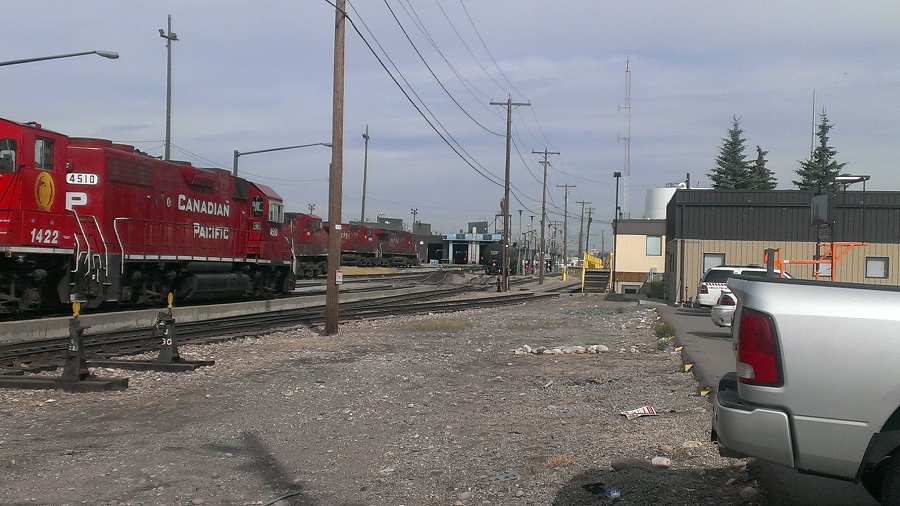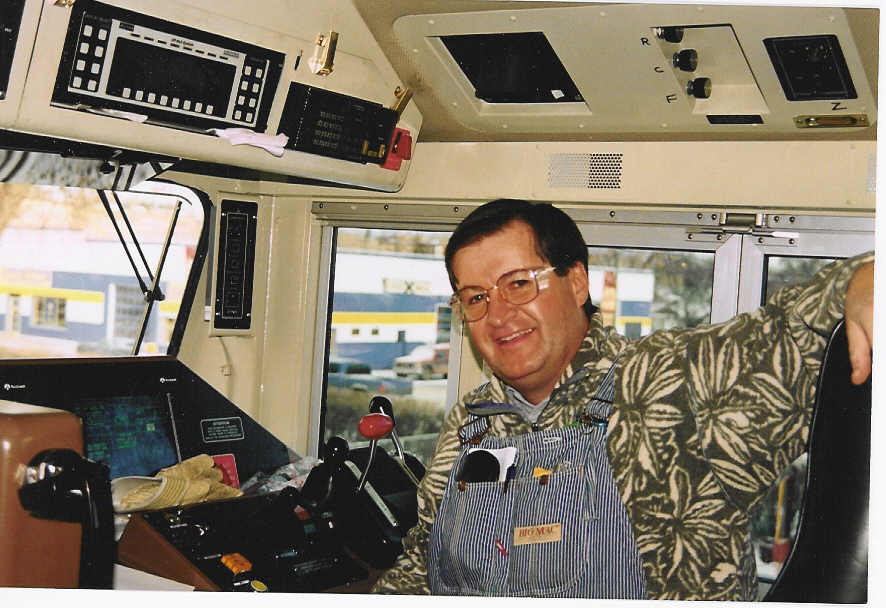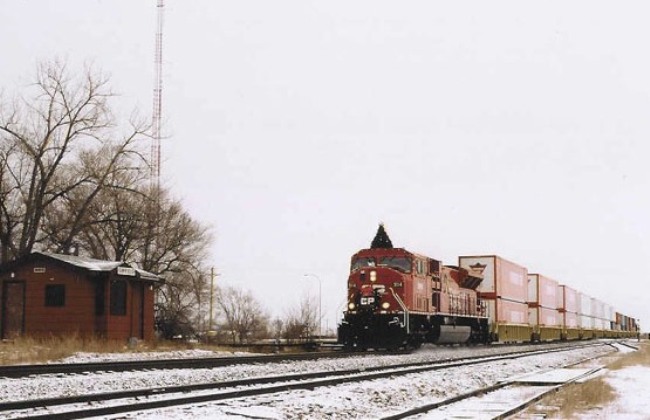
| WWT Shows | CLICK TO: Join and Support Internet Horology Club 185™ | IHC185™ Forums |

|
• Check Out Our... • • TWO Book Offer! • |
Welcome Aboard IHC185™  Internet Horology Club 185
Internet Horology Club 185  IHC185™ Discussion Site Main Page
IHC185™ Discussion Site Main Page  Interesting Horologically Based Stories
Interesting Horologically Based Stories  Larry Buchan's ..."Tales from the Rails"
Larry Buchan's ..."Tales from the Rails"  Canadian Pacific Railway's Holiday Train
Canadian Pacific Railway's Holiday Train
 Internet Horology Club 185
Internet Horology Club 185  IHC185™ Discussion Site Main Page
IHC185™ Discussion Site Main Page  Interesting Horologically Based Stories
Interesting Horologically Based Stories  Larry Buchan's ..."Tales from the Rails"
Larry Buchan's ..."Tales from the Rails"  Canadian Pacific Railway's Holiday Train
Canadian Pacific Railway's Holiday TrainGo  | New Topic  | Find-Or-Search  | Notify  | Tools  | Reply to Post  |  |
| Railway Historian IHC Life Member Site Moderator |
In the month of December 1999, I was working as a Locomotive Engineer, based in Calgary, on the Brooks Subdivision freight pool that ran from Alyth yard in Calgary, 171.1 miles East to Medicine Hat, Alberta. East of Medicine Hat is the Maple Creek Subdivision and going east it is 32 miles to the Alberta Saskatchewan border and 147.2 miles to Swift Current, Saskatchewan, where the next crew change is made. There were 32 engineers in the east freight pool, and we worked chain gang first in first out in the away from home terminal. On Sunday afternoon, December 19, 1999, I was called for train No. 428, a mixed freight train, with lots of traffic that was diverted south over the US border at Portal, Saskatchewan. This train was called for 15:30, I would report for duty at the Alyth Diesel Shops where I would book outward on the engineer’s outward report, check the bulletin board and sign all the new bulletins, and check my railway grade watch by phoning for the time signal. We were running Conductor only, and when the conductor Tony Hawkes had got all our clearances and train forms from the computer, we walked over to our power on the outward shop track, we had two of the newer General Electric locomotives CP 8596 and CP 8628. I would get on the power and check for documentation, a Schedule "A" that certified that the brake tests had all been done, I went back and released the chain operated locomotive handbrake, we then left the shop track. The Conductor radioed the Train Yard Coordinator and asked where our train was located, he gave us track P-10, he then radioed the Car Department Planner and ask for permission to tie on to our train, he replied that his men were all clear and we were okay to couple on. We then called the Pulldown Supervisor for a route to get to our train on the east end of Alyth yard, he told us it was okay to come down to the Pulldown Tower and work our way across to P-2 on the Bonnybrook bridge over the Bow River and back onto our train. We coupled on, and the conductor cut in the air to pump up the brake system, and then walked down the train taking off a dozen handbrakes the kept the train stationary while sitting in the yard as the yard had a grade downhill eastward towards the Bow River. The Carman, then performed a brake test, and signed the brake test form when finished, and stood beside the train to make a visual inspection on our departure. We then called the Pulldown and the Operator at the 12th Street E. interlocking tower for a route and permission to leave the yard. They Pulldown Supervisor gave us the okay to leave, and the operator at 12th Street E. said we were okay to go, and that he would crossover onto P-1 the mainline, on the east end of the Bonnybrook bridge. We got a slow clear signal on the crossover, I set my distance counter for the length of our 5328 foot train on the east end of the crossover and would know when we were clear of it, so I could open up the throttle to full speed, as we approached the clear signal at Ogden. The speed limit for freight trains was 55 mph so away we went, at 17:48, as we had no special dangerous commodities that would restrict our speed. No. 428 was a good train as it had no work to do along the Brooks Sub, and the Brooks Sub, as of 1998 was all Centralized Traffic Control, so all the siding switches along the 17 sidings between Shepard and Redcliff were controlled by the Rail Traffic Controller in the new Network Management Center located in downtown Calgary. We had an uneventful trip, taking the siding for some superior westbound freight trains, and holding the main track for meets with inferior drag freight trains, and extras. We arrived at Medicine Hat at 22:36 and were off-duty at 23:01, I booked eight hours rest, with a one-hour call so I would not be called before 07:00. A photo of our booking out and in building below the Alyth diesel shops, and power on the right side, ready for outgoing train crews.  | ||
|
| Railway Historian IHC Life Member Site Moderator |
After a good night's sleep I woke up, and was not called yet, so I checked the line up, on the computer terminal located in our bunk house. I could look up what trains they were going to run westward. I was first out and it looked like I was going to get a drag, at about 11:30 and after that was a special holiday train that was scheduled for 14:30. I had my breakfast and walked over to town to buy a submarine sandwich to eat for lunch on my trip home, I stopped by the station on my way back to the bunkhouse to check if there was any change in the lineup; the drag had fallen back to 13:00, which is nothing unusual with these no priority trains. I went back to the bunkhouse and sat in the TV room, talking with the other engineer Doug Kirk behind me in the pool who was supposed to get the special holiday train. At 13:15, the telephone rang and I answered it, it was a crew clerk calling from Winnipeg and gave me a call for the Holiday Train at 15:15, my power was CP 9114, and my conductor was Bob Gardner. The CPR Holiday Train was a public relations train being run by the CPR and cosponsored by some of their customers, Canadian Tire, Sears Canada, and others, the idea was raise money for the food banks across Canada. This was the first holiday train being run, I walked up from our bunkhouse to the station, and there was quite a crowd of people who came out to see the train. After booking outward, and getting all my paperwork, I went outside and took a couple of photos of the train arriving, I then climbed on board took some more photos from inside the cab. These new General Motors locomotives were my favorites, the ergonomics were nice, comfortable seats, grade soundproofing, desktop monitoring controls, built in cup holder, and clipboard for your train orders, and state-of-the-art computer type monitors, and extra one case one failed. They even had a pushbutton motor to apply the locomotives handbrake without leaving the cab of the locomotive. First photo Holiday Train arrives at Medicine Hat  | |||
|
| Railway Historian IHC Life Member Site Moderator |
CPR Holiday Train stops at Medicine Hat  | |||
|
| Railway Historian IHC Life Member Site Moderator |
Another view of the CPR Holiday Train at Medicine Hat  | |||
|
| Railway Historian IHC Life Member Site Moderator |
Changing crews at Medicine Hat  | |||
|
| Railway Historian IHC Life Member Site Moderator |
Controls from right to left, Independent brake handle, for locomotives brakes, with black knob, handle in full application position. Automatic brake handle, for trains brakes, with red T-bar handle in applied position. The little black panel besides the window is part of the remote sensor control, this technology replaced the old deadman's pedal, and works by the activity of the locomotive engineer, if you are in throttle eight, and have not done anything, the sensor starts flashing with an orange light, and further inattentiveness and audible whistle will start blowing, the way to nullify it is to press the orange reset button below the independent brake, or by blowing the whistle, changing the throttle position, or any other action, if no action is taken, the sensor will trip and the train brakes will go into emergency, and the locomotives power will be cut off. The next black handle is a dual purpose throttle control when pulled towards you, and a dynamic brake (locomotive electric brake that turns the traction motors on the train axles into generators that acts as a retarding force.) That is activated by shutting off the throttle and moving the handle into the upper quadrant. The RED switch above the throttle is the emergency application switch. The next black handle is the locomotive reverser, it is in the neutral position, and is pushed ahead to go forward, and pulled back to reverse the train. The black switch beside the reverser is the headlight control switch, and the orange square button, and round yellow one are to activate the bell and whistle. Beside my coffee cup are some more electrical switches, and the radio handset for calling the train dispatcher, (now called RTC's or Rail Traffic Controller) yardmaster, or section foremen. Out of sight above the window is the control pad for the radio, and electronic equipment for operating the locomotive through radio signals, called locotrol.  | |||
|
| Railway Historian IHC Life Member Site Moderator |
CPR 9114 Power Parking Brake application, but and meter.  | |||
|
| Railway Historian IHC Life Member Site Moderator |
One of the control screens that shows: "AIR BRAKES" shows that this is the LEAD locomotive, and that they are CUT IN, it also shows "FUEL QUANTITY" we have 3820 IMPERIAL GALLONS, there are many other functions that are controlled by the push pads on the screen.  | |||
|
| Railway Historian IHC Life Member Site Moderator |
My Conductor took this photo of me at the controls of the CPR 9114  | |||
|
| Railway Historian IHC Life Member Site Moderator |
The Conductor Bob Gardner, and I were ready to depart Medicine Hat, the Superintendent, Jimmy McFarland was on the platform, and gave us a highball to start our trip. I was surprised is usually they would send a Road Foreman of Engines along with you, we had clear signals, all the way, this photo shows the CPR Business Car on the tail end of our train departing Medicine hat, the red brick hotel in the background is the Assiniboia where I lived when I moved to Medicine Hat in the winter of 1973.  | |||
|
| Railway Historian IHC Life Member Site Moderator |
Robert Sandusky, a famous Canadian railway photographer took these two views of us arriving, and departing Suffield, that is 25.8 miles.  | |||
|
| Railway Historian IHC Life Member Site Moderator |
Departing Suffield  | |||
|
| Railway Historian IHC Life Member Site Moderator |
We made a stop at Gleichen Mile 124.8 where we picked up some officials, A Road Foreman of Engines on the head end, and some other officials got onto the business car on the tail end. | |||
|
| Railway Historian IHC Life Member Site Moderator |
The officials were still trying to decide where to change crews off at in Calgary, at first they thought they would stop at the gates to the CPR Ogden Shops, then they finally decided to do the change off at the Industrial Yard Office, where Fort Calgary is located. This photo shows us arriving at Alyth  | |||
|
| Railway Historian IHC Life Member Site Moderator |
Stopped at Fort Calgary a railfan took this photo of Bob Gardner and me.  | |||
|
| Railway Historian IHC Life Member Site Moderator |
Me and railfan Robert  | |||
|
| Railway Historian IHC Life Member Site Moderator |
Me at home reminiscing and wearing my CPR Holiday Train 1999 hat.  | |||
|
| Railway Historian IHC Life Member Site Moderator |
CPR Holiday Train 1999 Baseball cap  | |||
|
Larry, I found your post quite moving. It must be great to look back on good times like these. You have great photos which will always be there to remind you of a very different era. Thanks a lot for posting and all the best for Christmas and the future. Mike | ||||
|
| IHC Member 1110 |
Happy New Year to you Larry, thanks for this and all your other posts, I for one really enjoy them! You must have diesel fuel for blood,I know I do!...Ted. | |||
|
| Railway Historian IHC Life Member Site Moderator |
Thank you Mike and Ted for your kind remarks, and wishing you both the best in this new year, Ted, I would say a mixture of diesel fuel, coal, and valve oil as I have a great affinity for steam locomotives, and I was lucky enough to get to run some of them during my working career. Here is a photo from 1996 of CPR 1077 at Fort Steele, British Columbia Larry  | |||
|
| Railway Historian IHC Life Member Site Moderator |
CP 1077 is a Prairie steam locomotive wheel arrangement 2-6-2 (2 wheel leading truck supports weight of cylinders and acts as a pilot, 6 driving wheels, and 2 wheel trailing truck to support weight of firebox) an oil burner built by the Montréal Locomotive Works in 1923 and is still running.  | |||
|
| Railway Historian IHC Life Member Site Moderator |
My mentor Ernie Ottewell firing for me, Ernie is a good friend and is a retired locomotive engineer from Revelstoke, British Columbia, retiring as No. 1 on the British Columbia Locomotive Engineers, seniority list in the 1990s. That never slowed him down and he is active today hosting guests at the Revelstoke Railway Museum.  | |||
|
| Railway Historian IHC Life Member Site Moderator |
Oiling around at a station stop, a time honored tradition where the locomotive engineer walks around his steam locomotive checking the running gear, oiling and checking for hot bearings,  | |||
|
Great story and visual effects Larry! | ||||
|
| IHC Member 1110 |
Hi Larry,I have to ask if you know what your buddy Ernie used for a railroad watch? I'm always curious about what modern day railroaders use for watches.Thanks for the great posts and hope you're doing OK....Ted. | |||
|
| Railway Historian IHC Life Member Site Moderator |
Hello Ted: I overlooked your question, and will answer it now, Ernie during his CPR career used a Hamilton 992B pocket watch, it had quite a bit of wear on its No. 2 Bar over Crown case, I managed to find him a new crown and the gold filled piping over the crown.. Larry | |||
|
| Powered by Social Strata |
| Your request is being processed... |
|
Welcome Aboard IHC185™  Internet Horology Club 185
Internet Horology Club 185  IHC185™ Discussion Site Main Page
IHC185™ Discussion Site Main Page  Interesting Horologically Based Stories
Interesting Horologically Based Stories  Larry Buchan's ..."Tales from the Rails"
Larry Buchan's ..."Tales from the Rails"  Canadian Pacific Railway's Holiday Train
Canadian Pacific Railway's Holiday Train
 Internet Horology Club 185
Internet Horology Club 185  IHC185™ Discussion Site Main Page
IHC185™ Discussion Site Main Page  Interesting Horologically Based Stories
Interesting Horologically Based Stories  Larry Buchan's ..."Tales from the Rails"
Larry Buchan's ..."Tales from the Rails"  Canadian Pacific Railway's Holiday Train
Canadian Pacific Railway's Holiday Train©2002-2025 Internet Horology Club 185™ - Lindell V. Riddle President - All Rights Reserved Worldwide

